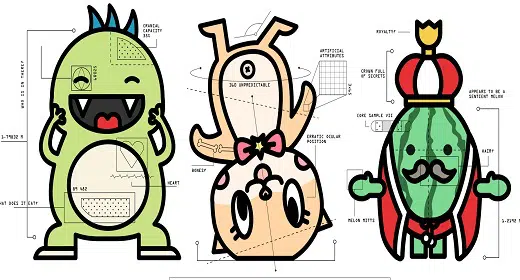In Japan, mascots are more than a cultural phenomenon. They’re a billion-dollar business…
Jacu-jii is a human jacuzzi faucet who represents the Osaka Waterworks Bureau. A boxing rabbit named Super Hakuto-kun is the face of an express train service. There’s Melon Kuma, a terrifying, tourism-promoting fruit-bear hybrid, and Colon-chan, a character with hot pink, intestine-shaped hair, who encourages colonoscopies.
In the United States, mascots are designed to appeal to children and are typically associated with sports and consumer brands. This is not true in Japan, where almost every brand, prefecture, and local government is represented by a mascot, promoting everything from local produce to pachinko parlors and generating billions of dollars in the process. And unlike American mascots that exist to stand out, Japanese mascots are made to blend in.
:no_upscale()/cdn.vox-cdn.com/uploads/chorus_asset/file/19785143/Hikonyan.jpg)
This is the heart of “yuru-chara,” the championing of mascots as part of everyday life. Japanese artist Jun Miura is widely credited with coining the term in 2009, outlining three fundamental components of a yuru-chara mascot:
- It must convey a strong message of love for one’s hometown.
- Its movements should be unique and unstable or awkward.
- It should be unsophisticated or laid-back and lovable.
It’s a recipe that works for a Japanese audience, a mixture of regional loyalty and self-deprecation in a place where celebration of the absurd flourishes. Though reverence for non-human characters can be traced back to the cultural impact of Kami, the spirits which form the foundation of the polytheistic Shinto religion, the recent proliferation of yuru-chara began in 2007 with Hikonyan, a samurai cat created by the Hikone city government to mark the 400th anniversary of Hikone Castle. The mascot wasn’t just popular — it was a phenomenon. People flocked to see Hikonyan, generating more than $200 million in tourism spending. Other cities took note, hoping to replicate Hikone’s success with mascots of their own. Brands and businesses followed suit.
Though yuru-chara was initially rooted in connecting people to brands, the public’s love for the characters themselves soon created a demand for apparel, accessories, food, toys, and just about anything else that could be branded with a mascot’s image. Merchandise sales reached a reported $16 billion in 2012, and fan loyalty has only continued to grow.
:no_upscale()/cdn.vox-cdn.com/uploads/chorus_asset/file/19785149/domo_kun.jpg)
Chris Carlier runs “Mondo Mascots,” a popular Twitter account that highlights the best and worst of Japan’s mascot culture, which fascinated Carlier when he first moved to Tokyo from Britain. Though Carlier has spoken to many of the people inside the costumes, they never reveal their identities, always speaking in character, and only for short periods. Many of them are full-time employees who spend most of their time making public appearances, he says, especially if they represent a brand or large city. The job is less glamorous in smaller prefectures where characters are often played by “reluctant young town hall employees” roped into the role.
Yuru-chara has had a fair share of international exposure, though people might not realize it. Domo, a fluffy, saw-toothed monster who represents Japan’s public broadcaster, Nippon Hoso Kyokai, gained widespread popularity in fledgling meme communities Newgrounds and YTMND as early as 2001. As one of the internet’s first identifiable memes, it wasn’t long before Domo merchandise flooded the western market, even if people didn’t know where the image came from.
During the 2018 World Cup in Russia, Ippei-Kun caught the imagination of soccer fans with tweets full of ennui and existential dread. Ippei-Kun’s Twitter account became a must-follow element of the World Cup itself, elevating each of Japan’s games and turning them into something wholly special. The juxtaposition of a cute mascot with soul-crushing despair resonated with a western audience largely because of how weird it was, but also how perfectly it mirrored society.
Carlier says elements of yuru-chara can even be found in the U.S., particularly when it comes to the cult-like following surrounding Philadelphia’s sports mascots, which he considers the cream of the crop.
:no_upscale()/cdn.vox-cdn.com/uploads/chorus_asset/file/19785144/Ippei_kun.jpg)
“Gritty or the Phillie Phanatic are as bonkers as any you’d find in Japan,” he says.
Gritty, the Philadelphia Flyers’ beloved orange fur-covered giant, is arguably the most popular mascot in American sports. Why? Because he’s weird. More than simply entertainment for children, Gritty routinely harasses reporters, fans, and players with his antics and is no stranger to controversy. Even people who would never identify as sports fans still recognize Gritty as part of the city’s identity.
While that spirit defines Japanese mascot culture, an existential threat hangs over the long-term future of yuru-chara: the weight of its own popularity. There are so many mascots in Japan, government officials have pushed for a culling of less popular mascots to keep the yuru-chara system alive. The Yuru-Chara Grand Prix is an annual contest where fans vote for their favorite mascots, which also keeps tabs on the popularity of government-sponsored characters. While it helps justify why certain mascots have value, it also serves to push out those who are underperforming.
It’s unclear whether yuru-chara will continue in perpetuity. What is evident, however, is officials are terrified of seeing the culture end entirely given the massive boon to local economies and governments that would otherwise struggle for funding. With the incredible success of yuru-chara comes the understanding that oversaturating the market could cause it to collapse.
For now, yuru-chara thrives in Japan, where everything has a mascot, and every mascot has a purpose — at least until the next big thing comes along.





















































